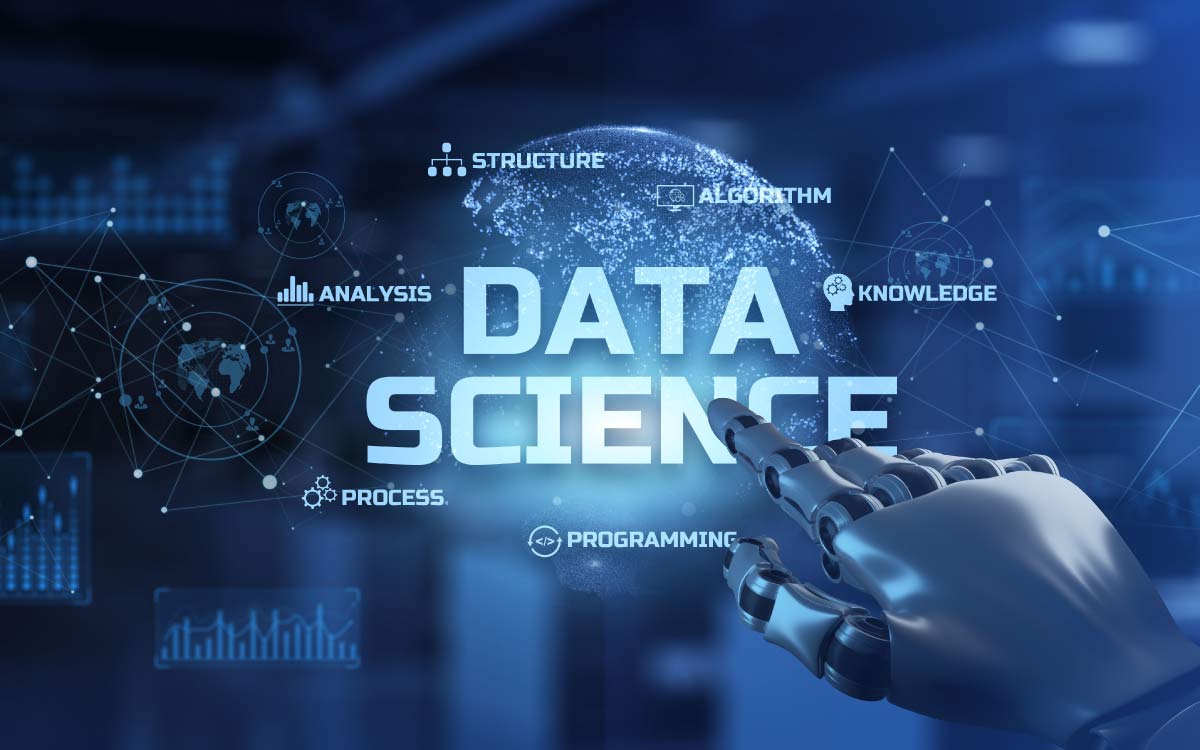Whether it’s the algorithms behind our favorite apps or the models forecasting climate change, data science drives these innovations and many others we encounter daily. Data science involves various processes, tools, structures, and algorithms to transform data into something meaningful and valuable. But what are the core components of data science?
That’s what we’ll cover in this article. Knowing these components is part of the basic knowledge you must possess as an aspiring professional.
If you want to advance your knowledge, we recommend enrolling in an online data science program.
What is Data Science?
Data science is a dynamic and interdisciplinary field that uses various tools and techniques to turn data into insights. It involves using machine learning, statistics, data visualization, and programming to uncover patterns and trends from structured and unstructured data.
Some data science applications include analyzing customer behavior to enhance marketing strategies, personalizing recommendations on streaming platforms like Netflix and Spotify, and detecting fraud in financial transactions.
Also Read: What is Data Visualization, and What is its Role in Data Science?
The Main Components of Data Science Projects
Understanding the critical components of data science provides a solid base for tackling complex projects.
1. Data and Data Collection
Data collection is the first component of a data science project. It involves gathering information from various sources to answer questions or solve problems. The data is then divided into structured and unstructured data.
Structured Data
Structured data is organized in a way that is easy to manage and analyze. Examples include:
- Relational databases: Store data in tables where each row is a record and each column is an attribute. Examples include MySQL and PostgreSQL.
- Spreadsheets: Tools like Microsoft Excel and Google Sheets manage and analyze structured data using tables and charts.
Data engineers play a crucial role in managing structured data by:
- Designing and maintaining databases: Setting up and managing relational databases to efficiently handle large volumes of data.
- Developing data warehouses: Integrating data from various sources into warehouses using technologies like Amazon Redshift or Google BigQuery.
- Implementing data integration: Using tools like Apache NiFi to combine data from different sources, ensuring it is consistent and accessible.
Unstructured Data
Unstructured data has no predefined format and includes text documents, social media posts, and multimedia content. Handling this data involves:
- Text mining: Utilizes natural language processing (NLP) to extract meaningful information from text. Libraries like NLTK and SpaCy are used for sentiment analysis and topic extraction.
- Multimedia analysis: Tools like OpenCV and TensorFlow analyze images and videos, recognizing patterns and objects.
- Data crawling: Tools like Scrapy help collect unstructured data from websites, enabling the extraction of large data sets.
For unstructured data, data engineers:
- Set up data processing systems: Design systems for processing text, images, and videos to ensure the data is ready for analysis.
- Manage data crawlers: Implement and maintain web crawlers to extract data from diverse sources.
2. Data Engineering
Data engineering focuses on designing and maintaining robust systems for efficient data processing and storage. By structuring data effectively, data engineers enable accurate and timely analysis and ensure that data is accessible and reliable.
Data Cleaning and Transformation
Cleaning and transforming data involves:
- Handling missing values: Techniques like imputation fill gaps in data using statistical methods or domain knowledge.
- Data normalization: Adjusts data to a standard scale using min-max scaling or z-score normalization methods.
- Removing duplicates: Identifies and eliminates duplicate records to ensure accuracy.
Data engineers handle these tasks by:
- Developing ETL processes: Create pipelines for extracting, transforming, and loading data, ensuring it is clean and well-organized.
- Automating data transformation: Implement automated processes to efficiently handle data cleaning and transformation.
- Maintaining data quality: Regularly monitor and improve data quality through automated and manual checks.
Data Integration and Storage
Integrating and storing data involves:
- ETL (extract, transform, load): Moves data from various sources, converts it into a usable format, and loads it into storage systems.
- Data lakes: Store large volumes of raw data in data lakes using technologies like Apache Hadoop and Amazon S3.
In data integration and storage, data engineers:
- Build and maintain ETL pipelines: Develop and manage pipelines for efficient data integration.
- Design data lakes: Set up data lakes to handle diverse data types and large volumes.
- Ensure data accessibility: Implement systems that make data easily accessible for analysis.
Also Read: The Top Data Science Interview Questions for 2024
3. Data Infrastructure
Data infrastructure involves setting up and managing efficient data processing and storage systems. This includes configuring servers, databases, and data pipelines to collect, organize, and handle large volumes of data.
A well-designed data infrastructure ensures data is accessible, secure, and ready for analysis, supporting effective decision-making and operational efficiency.
- Distributed computing: Technologies like Apache Spark and Hadoop handle large data sets across distributed systems.
- Real-time data processing: Tools like Apache Kafka and Apache Flink manage real-time data streams for immediate insights.
Data engineers are responsible for the following:
- Deploying distributed systems: Set up and manage distributed computing frameworks for scalable data processing.
- Implementing real-time solutions: Create systems for processing data in real-time, ensuring timely insights.
4. Statistics
Statistics is essential for analyzing and interpreting data. They help summarize data and draw meaningful conclusions from it.
Descriptive Statistics
Descriptive statistics include:
- Mean: The average value of a data set.
- Median: The middle value when data is ordered.
- Standard deviation: Measures the spread of data points around the mean.
Data engineers support descriptive statistics by:
- Providing clean data: Ensure that data used for statistical analysis is clean and well-organized.
- Building data pipelines: Create pipelines that prepare data for statistical and analytical tasks.
Inferential Statistics
Inferential statistics involve:
- Hypothesis testing: Methods like t-tests and chi-square tests are used to generalize a population based on sample data.
- Confidence intervals: Provide a range within which a population parameter will likely fall.
Also Read: Data Science Bootcamps vs. Traditional Degrees: Which Learning Path to Choose?
5. Predictive Modeling
Predictive modeling uses statistical methods to forecast future events. Techniques include:
- Regression analysis: Predicts outcomes based on input features using linear and logistic regression methods.
- Time series analysis: Analyze data over time to identify trends and make forecasts.
Data engineers assist with inferential and predictive statistics by:
- Preparing data: Ensure data is structured and cleaned for accurate statistical modeling.
- Supporting model deployment: Implement systems to deploy predictive models in real-world scenarios.
6. Machine Learning
Machine learning (ML) is a component of data science that involves training algorithms to learn from data and make predictions or decisions.
Supervised Learning
Supervised learning uses labeled data to train models. Techniques include:
- Classification: Categorizes data into predefined classes, such as spam detection or image recognition.
- Regression: Predicts continuous outcomes, like prices or sales figures.
Data engineers:
- Prepare training data: Develop and manage data sets used for training ML models.
- Optimize data pipelines: Ensure pipelines can handle the volume and complexity of ML tasks.
Unsupervised Learning
Unsupervised learning works with unlabeled data to find patterns. Techniques include:
- Clustering: Groups similar data points used in customer segmentation or market analysis.
- Association rules: Identifies relationships between variables, such as products frequently bought together.
Reinforcement Learning
Reinforcement learning trains models to make decisions by maximizing rewards. Concepts include:
- Q-Learning: Find the best action-selection policy for an agent.
- Deep reinforcement learning: Combines reinforcement learning with deep learning for complex environments.
Data engineers contribute to machine learning by:
- Building infrastructure: Set up systems for training and deploying ML models.
- Handling large data sets: Manage and process data sets required for complex ML tasks.
Also Read: Career Roundup: Data Scientist vs. Machine Learning Engineer
7. Programming Languages
Programming languages are essential tools for implementing data science methods. Key languages include:
Python
Python is popular in data science due to its simplicity and libraries:
- NumPy: Handles large arrays and matrices with mathematical functions.
- pandas: Provides structures for data manipulation.
- scikit-learn: Offers tools for classification, regression, and more.
Data engineers use Python to:
- Automate workflows: Write scripts for data processing and analysis.
- Develop pipelines: Create and manage data pipelines.
R
R is used for statistical computing and data analysis:
- ggplot2: Creates complex data visualizations.
- dplyr: Manipulates data with functions for filtering and summarizing.
SQL
SQL manages and queries relational databases:
- Data querying: Retrieves data using commands like SELECT and JOIN.
- Data manipulation: Modifies data with commands like INSERT and UPDATE.
Data engineers use SQL to:
- Query databases: Retrieve and manipulate data from relational databases.
- Manage storage: Ensure efficient data storage and retrieval.
8. Big Data
Big data refers to data sets that are too large or complex for traditional tools to handle. Key characteristics include:
- Volume: Big data involves massive data sets requiring specialized storage and processing.
- Variety: Includes diverse data types, such as structured and unstructured data.
- Velocity: Requires real-time processing to manage rapid data generation.
What data engineers do:
- Implement big data technologies: Set up tools like Hadoop and Spark for large-scale data processing.
- Manage data flow: Ensure systems handle rapid data collection and processing.
Also Read: What is A/B Testing in Data Science?
9. Domain Knowledge
Specialized knowledge of a particular industry or field is crucial for interpreting data accurately and making decisions aligned with business goals.
While not typically domain experts, data professionals benefit from having domain knowledge so that they can:
- Ensure data systems meet industry requirements.
- Adapt data infrastructure to fit specific domain needs.
Ready for the Next Step? Master the Essential Data Science Skills
Data science combines various components to transform raw data into actionable insights. From data collection and engineering to predictive modeling and machine learning, each element plays a vital role in leveraging the power of data.
As an aspiring data science professional, deepening your knowledge in these areas is essential. Enroll in a data science program to gain the crucial skills needed for a successful career in this fast-evolving field. Developed in collaboration with IBM, the bootcamp covers core components of data science, including data analysis, predictive modeling, data visualization, generative AI, and more. Engage in over 25 hands-on projects, earn a prestigious certificate, and benefit from career support services.
You might also like to read:
What is Natural Language Generation in Data Science, and Why Does It Matter?
What is Exploratory Data Analysis? Types, Tools, Importance, etc.
What is Data Wrangling? Importance, Tools, and More
What is Spatial Data Science? Definition, Applications, Careers & More
Data Science and Marketing: Transforming Strategies and Enhancing Engagement






